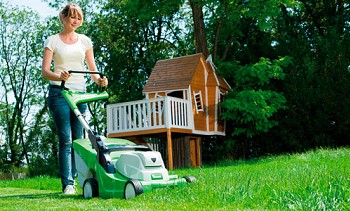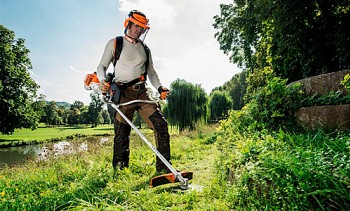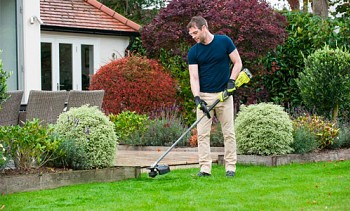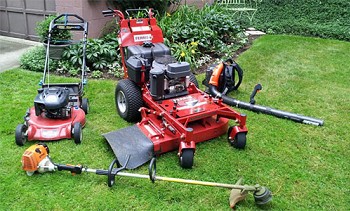With the advent of spring, we, tired of the long winter from the white-gray monotony, sincerely rejoice in the appearance of green grass. However, this joy does not last long. Very soon, weeds grow so much that it takes a lot of effort to control them.
An ordinary scythe is unlikely to become an assistant in solving this problem: few modern city dwellers can use it, and it is only good in spacious areas where fruit trees, garden benches, fences, curbs do not come across at every turn ...
Well, today there is a great alternative, easy to use and convenient in confined spaces - a brushcutter, or trimmer. Now we will consider how to choose a good gas trimmer for cutting grass and take into account all the nuances.
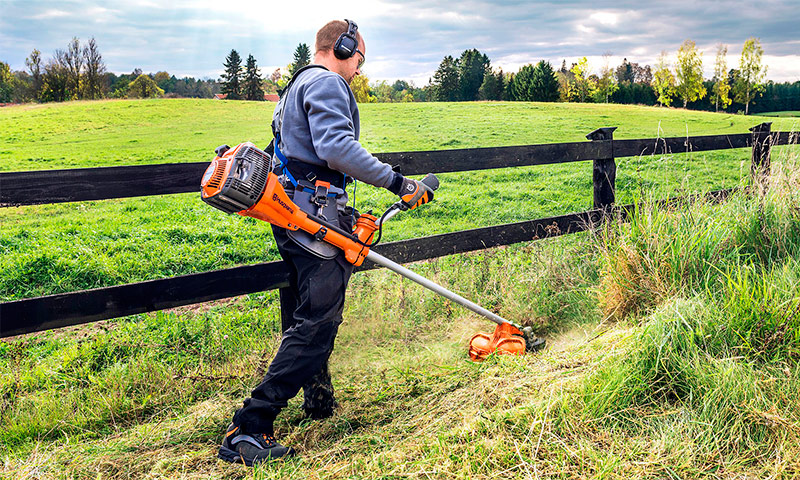
Content:
Gas trimmer device
Numerous models of hand-held motokos available on the market today differ in power (and, as a consequence of this, in their capabilities), weight, and the presence of certain additional functions that increase usability, but the circuit diagram of the tool remains unchanged.
An internal combustion engine is used as a power drive in any gas trimmer. By means of a rigid or flexible shaft, rotation from it is transmitted to the cutting element - a coil with cord (fishing line) or a special knife. The shaft is located inside a metal rod, at one end of which the engine and the fuel tank are fixed, at the other is a cutting head. A handle is mounted in the middle of the bar. Most often it is on it that the keys, buttons and switches are placed, with the help of which the operation of the trimmer is controlled.
The layout of the controls may vary slightly depending on the model of the tool, but as a rule, this includes a button to turn off the engine, a throttle button that allows you to control the throttle of the carburetor, and a stopper of this button when pressed, making it easier to control for large volumes of work.

1. Gearbox.
2. Trimmer head.
3. Protective cover.
4. Throttle lock button.
5. Switch.
6. Gas lever.
7. Lever.
8. Gas lever lock.
9. Barbell.
10. Loop for attaching a carabiner belt.
11. Air filter.
12. Spark plug.
13. Motor housing.
14. Exhaust manifold.
15. Gas tank.
16. Starter.
Determine the type of gas trimmer
All the trimmers and brush cutters available on the market today, depending on their capabilities and purpose, are divided into three classes: domestic, semi-professional and professional. Which tool do you need? This primarily depends on the tasks that will be assigned to it.
Household gas trimmers
Household trimmers are designed for mowing low grass in a relatively small area, the area of which does not exceed 10-15 hundred parts. As a rule, we are talking about caring for the lawn near the house. They are not capable of anything more: household trimmers do not withstand long work, 1-1.5 hours a day is their limit. Due to the modest in power (no more than 1-1.5 hp) and engine dimensions, such a tool is light in weight, which means that it can be used without special support belts.

Often household trimmers are equipped with a curved bar.The curved bar of the household trimmer increases its maneuverability and makes it easy to cut grass in hard-to-reach places, for example, around bushes. However, due to this design of the rod, a flexible shaft is installed inside, which negatively affects the reliability of the tool. A cord (a special fishing line) is usually used as a cutting element in a household trimmer, although some knives sometimes include plastic knives as an addition.
Semi-professional, or farm
Semi-professional trimmers are often called farm trimmers, and this fully reflects their purpose. This is a reliable assistant to a resident of the countryside, designed for regular high loads. A similar tool can work for 3-4 hours a day, mowing grass on a plot of 20-30 acres. Of course, such a trimmer needs a more powerful engine - 1.5-2.5 hp. Semi-professional models, unlike household ones, are always equipped with a straight bar and a rigid shaft, which increases their reliability. The cutting part is represented not only by the trimmer head, but also by knives. The latter will help to mow especially tall and thick grass, moreover, they are able to cope even with weeds and branches of bushes.

Professional, or landscape gardening
Professional trimmer is a powerful tool for employees of urban improvement services, gardening enterprises and public utilities. It is equipped with an engine with a power of more than 2.5 hp, has an increased motor resource and is ready for many hours of daily work. In addition to the trimmer head, metal knives can be installed on such units, able to cope with dense shrubbery and unnecessary shoots of trees with a trunk thickness of up to 3 cm in diameter.
It is easy to guess that professional trimmers have a reinforced bar and a spacious fuel tank. Since such tools are quite massive, they are necessarily equipped with special belts to ease the load on the operator’s hands and a professional vibration damping system. It is clear that to acquire a professional trimmer for cutting a lawn next to a private house is simply not practical.

Type of gasoline engine
On gasoline trimmers, both two-stroke and four-stroke engines are installed. This is not to say that a particular variety has clear advantages. At least, there is no direct connection between the type of engine and its power - there are household models with a four-stroke engine, and professional models with a two-stroke.
2-stroke engine
Two-stroke engines compared to four-stroke ones, having a lower weight, operate in a higher speed range, which provides greater performance. Of course, two-stroke engines "eat" more fuel and produce a lot of noise and exhaust, but at the same time they bribe with their unpretentiousness in work. Work with a trimmer equipped with a two-stroke engine will have to begin each time with the preparation of a gasoline-oil mixture, but if such an engine suddenly fails, you will most likely not be able to reanimate it.

4-stroke engine
Four-stroke engines are devoid of almost all the disadvantages inherent in two-stroke ones: during operation, they produce much less noise, their exhaust gas volume is significantly lower, and gasoline and motor oil are poured into different containers.

They are more economical in terms of fuel consumption and have a higher motor resource. All this, however, does not mean that four-stroke ICEs are ideal. No, they have their drawbacks.
The design of such an engine is more complicated, which means that its maintenance and repair are more complicated. A four-stroke will always be heavier than the power of a two-stroke equal to it, which negatively affects the weight of the entire tool and, therefore, the ease of handling.And finally, a trimmer equipped with a four-stroke engine will be more expensive than the same, but with a two-stroke ICE.
It should be noted that along with the classic four-stroke engines, there are also hybrid ones: they have a duty cycle of 4 cycles, but the lubrication system is similar to a conventional two-stroke engine.
Engine starting system
The engines of most gas trimmers are started manually: sharply pulling out the cable (starter cord), you thereby unwind the drum, which in turn drives the engine crankshaft.
Some modern trimmer models feature the Flash Starter easy-start system. By pulling the cable, you cock a special spring in several stages, which, having accumulated energy, will transmit it to the crankshaft, which will become the impetus for starting the engine. With the Flash Starter system, the engine starts more easily, because the spring gives a faster spin speed than can be done by hand. The operator now requires less physical effort, because he no longer needs to make sharp jerks of the cord, the cable can be pulled slowly and smoothly.
How the easy start of the benzotrimmer occurs, see the video:
To facilitate starting the engine, the power unit of the tool, as a rule, has a special button, a few presses of which before starting will ensure the supply of the required amount of fuel to the carburetor.
Tool power
How to choose a gas trimmer for mowing grass on a personal plot? And for processing the "plantation" with an area of a couple of hectares? That's right, focusing on its power.
The power of a gasoline engine mounted on trim tabs can vary from 1 to 3-3.5 hp. The choice of a tool for this parameter directly depends on the expected load. It is the power of the trimmer that determines its operational purpose. So, for mowing the lawn near the house, a simple tool with a capacity of not more than 1.5 liters will be enough. from. A far more powerful engine is installed on farm trimmers - from 1.5 to 2.5 liters. from. The whole range of trimmers' capabilities can be demonstrated only by a professional tool with a power exceeding 2.5 hp.
It is clear that an increase in the power of an instrument inevitably entails an increase in its weight and cost. It follows from this that when choosing it is not necessary to chase thoughtlessly at high power indicators, but focus primarily on the planned scope of the tool.
Gas trimmer rod and shaft
The trimmer bar, inside which there is a shaft transmitting rotation from the engine to the working head, can be either straight or curved. The first is more reliable, the second is more ergonomic. Direct rods are installed on professional and semi-professional tools. The transmission shaft located inside such a rod is a rigid rod made of especially strong steel. The risk of damage to such a shaft, even with significant loads, is small.

Hard shaft.

Straight barbell.
On petrol trimmers with a rigid shaft, the torque from the shaft to the cutting tool is transmitted through a gearbox with bevel gears. Gearboxes can be serviced and not serviced. The serviced gearbox has a process hole through which grease can be replaced or added. In non-serviceable greases, the grease is laid by the manufacturer for the entire service life. Some users find that an unattended gearbox is less durable. In turn, manufacturers note that this step is aimed at increasing the life of the gearbox, since according to statistics, very often, gearboxes fail due to improper dosing of lubricant or ingress of foreign objects during maintenance.

A curved bar is typical for lightweight household trimmers. It is more convenient to use a tool with a curved bar to cut grass in close proximity to bushes and trees, benches, a fence, etc. The downside of this convenience is the lower reliability of such tools.The fact is that in this case it is possible to transfer rotation from the engine to the cutting element only by means of a flexible drive, and the latter is more vulnerable than a rigid shaft, and its probability of failure is much higher.

Flexible shaft.

Curved barbell.
The benzotrimmer bar may be solid or collapsible. A one-piece transmission shaft (and this is a guarantee of reliability) can only be installed in a one-piece rod. But transporting and even just storing such an instrument is less convenient. A collapsible bar, consisting of two or more sections, on the contrary, provides compactness during transportation and storage. The drawback of the split rods is obvious: the transmission shaft must also disconnect, and any drive connection is an additional vulnerability. In addition, the earth, sand and other debris can fall into the rod during disassembly, which leads to premature wear of the working elements.

Handle type
Filigree control of a rather heavyweight unit is not as simple as it might seem at first glance. When choosing a trimmer, special attention should be paid to the handle configuration, on which the ease of use of the tool directly depends. There are several varieties of handles:
T - shaped handle, outwardly resembling a bicycle wheel, allows you to make wide movements and is convenient for quite a long work, so it can often be seen on trimmers of a professional and semi-professional class. All tool controls (starting, speed adjustment, etc.) are located directly on one of the handles, which greatly simplifies the work and increases safety.

J - shaped handle characteristic for light household trimmers. With its help, it is easier to control the tool, performing fine maneuvering. All the buttons necessary for the operator are not located on the handle, but on the bar.

D - shaped handle, like the J-shaped, it is installed only on light trimmers intended for home use, as it is designed to hold the tool with one hand.

Before choosing a gasoline motocosa, the future user must hold it in his hands and evaluate the degree of convenience. It should be borne in mind that the handle of any type can be moved along the bar, adjusting the tool to fit your height and other individual characteristics and thereby achieving maximum ergonomics. It is convenient to work with benzotrimmers with D and J-shaped handles in cramped conditions, narrow aisles, which are not uncommon in household plots.
Belt system
Only a good shoulder strap that redistributes part of the weight to the back and shoulders of the operator can reduce the load on the hands when working with a rather heavy hand tool.
Shoulder system of belts. For comfortable use of a relatively light household trimmer, a simple one-shoulder belt is sufficient. If you have to work a motocosa of a semi-professional or professional class, we strongly recommend that you look after products with two-shoulder belts.

Knapsack belt systems although they cost more, they distribute the weight of the tool more evenly on the shoulders and back of the user, which means they significantly reduce fatigue during hours of weed control.

Such satchels are often equipped with special bags for storing cutting equipment, as well as tools that may be needed to repair the trimmer in the field. A special pad, which manufacturers supply the belt system, protects the operator’s thigh from burns when it comes in contact with an engine that has been very hot during operation and reduces the level of transmitted vibration.

Additional amenities
The presence of anti-vibration system
During the operation of the trimmer, vibrations occur, which is generally characteristic of any mechanism whose individual elements make fast reciprocating movements.Vibrations can cause the operator to experience significant discomfort while working, and with frequent use of the instrument, he may experience health problems, the most predictable of which is premature wear of the elbow joints.
A special anti-vibration system will help to significantly reduce the vibration effect on the body of a person working with a trimmer. In the simplest and most common embodiment, it is a set of polymer gaskets located between different structural elements of the trimmer.

Anti-vibration system of a brushcutter.
Such gaskets reduce the transmission of vibration and thereby provide normal working conditions for the user with the tool. Often, manufacturers to dampen vibrations additionally separate the engine from the rod with special shock absorbers. Almost all the world's leading brands equip their products with an anti-vibration system today.
Fuel tank capacity
The capacity of the fuel tank can vary from 0.3 to 1 liter, depending on the model. Which trimmer tank, large or small, should I prefer? Both this and the other option have their advantages and disadvantages. A large tank increases the weight of an already heavy unit, but does not require a frequent stop for refueling.
A tank of a smaller capacity, in turn, is smaller and heavier, contributes to more economical fuel consumption, but at the same time it does not allow for continuous non-stop operation. Choosing a trimmer by such a parameter as the volume of the fuel tank, you should focus on your physical abilities and the size of the area that you have to regularly mow. It is very convenient if the fuel tank is made of translucent plastic - this allows you to track the amount of fuel remaining in it during operation.
Device weight
The convenience of working with a trimmer directly depends on its weight, because the entire load falls on the arms and shoulders of the person performing the operation. If the tool turns out to be too heavy for you, no matter how powerful it is and no matter how well the grass is mowed, the final result is unlikely to be satisfactory: you simply can’t work for a long time and manage it carefully, reaching hard to reach areas.
That is why when choosing a trimmer, you should definitely pay attention to the weight of the device, especially if you yourself can not boast of heroic strength. Do not chase power. In many cases, it is more rational to purchase a less powerful, but at the same time lighter unit: you will spend a little more time mowing your site, but you won’t get tired so much that you don’t finish the job.
What you need to know about working equipment
Either cord (a special cutting line) or knives can act as a working element of a motokosa directly cutting off excess vegetation. These are consumables, even if they are included in the factory tool kit, over time they will have to be purchased and replaced. The choice of equipment used depends on the tasks that you plan to solve with your trimmer, and primarily on the thickness and density of the grass to be mowed.
Trimmer head
Almost all trimmers are equipped with a trimmer head - a coil designed for winding a cutting line. According to the method of feeding the fishing line, all trimmer heads are divided into mechanical (you have to manually pull the ends of the line yourself), semi-automatic (the line is released when you press the wide button on the lower plane) or automatic (the extension of the protruding ends of the line occurs automatically when the engine speed is reduced). Semi-automatic cord feeding is considered the most effective, such heads are most popular among users.

In addition, the trimmer heads can vary according to the maximum allowable diameter of the mowing line, which can be tucked into the reel.On household trimmers usually set fishing line with a diameter of 2 to 2.4 mm, on semi-professional - from 2.4 to 2.7 mm, on professional - from 2.7 to 3 mm.
When choosing a trimmer head, be sure to pay attention to the material from which its lower part is made. It is this part that is the most vulnerable, since it constantly hits the ground, and it is it that most often causes the trimmer head to fail.
Knives
For mowing particularly thick grass, reeds, shrubs, young shoots of trees, not a fishing line is used, but special knives (cutters). On sale you can find a huge number of varieties of knives for trimmers, differing in material (metal or plastic), shape, number of cutting blades. By the way, cutters, unlike fishing lines, do not crush grass, which means that they can be used for mowing for harvesting purposes.
Which knife to choose for your trimmer? When solving this issue, first of all, one should focus on the recommendations of the manufacturer, indicating the possibility of using this or that type of equipment on this model. Excessive independence in the choice of knives and cutters can lead to failure of the trimmer.
Gas trimmers manufacturers
Any garden equipment store will offer you today dozens of trimmer models from different manufacturers. Stihl, Makita, Husqvarna, Hitachi, Oleo Mac, Caiman, Stiga, Huter, ECHO, Carver ... Which brand trimmer should I prefer? Motokosa with what name on the nameplate to choose for the refinement of the infield or for large-scale professional work? We will not be engaged in advertising individual brands, but we will give some recommendations that will help you choose a truly reliable tool from the variety available.
1. Today on the market you can find many trimmers "no name", usually made in China. Of course, they are very captivating at their cost, but you should not hope for the reliability of such a technique. As practice shows, such an instrument quickly becomes worthless without even paying back its low cost. Of course, there is no talk of any guarantees or service in this case.

2. A big plus when choosing a particular brand of trimmer will be the presence of an official representative of this brand in your region. This will guarantee that if your motokosa nevertheless fails, you will be provided with quick technical support. You can easily find parts for your product, and at prices that are not overstated by numerous resellers.

3. Regardless of the choice made, the tool should only be purchased in specialized stores.
Do not forget to read the warranty conditions and make sure that the seller makes a mark on the date of sale in the warranty card.






